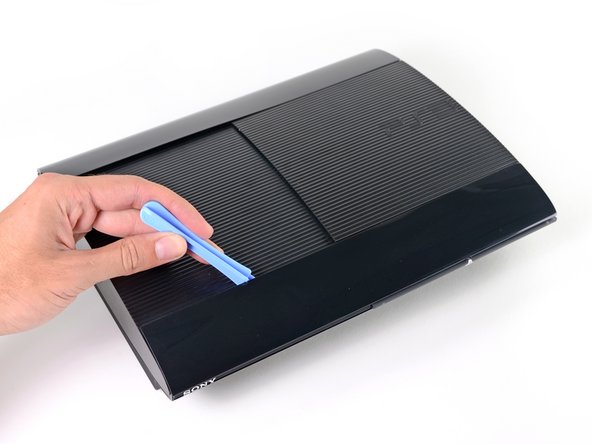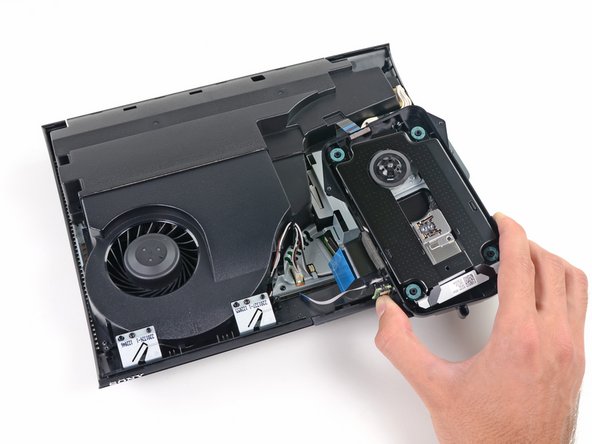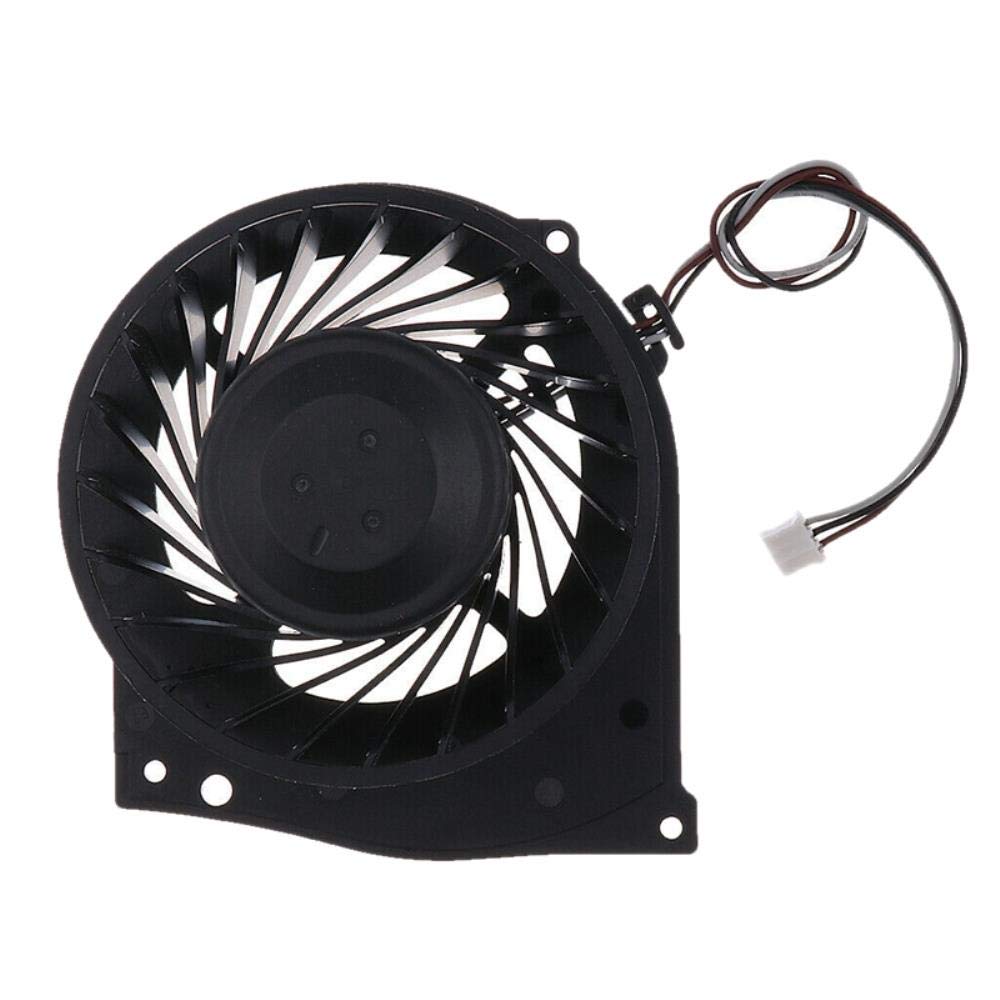PlayStation 3 Super Slim WiFi Antenna Replacement
Duration: 45 minutes
Steps: 24 Steps
Dive into the PlayStation 3 Super Slim Teardown and get a peek at what makes this console tick, with a special spotlight on the motherboard. If you’re here to replace the antenna, jump straight to Step 19 for the details. Let’s do this!
Step 1
– Get ready to unleash the power of the PlayStation 3 Super Slim! This little dynamo is packed with impressive features in a sleek design. Here’s what you can expect:
– HD output options: 1080p, 1080i, 720p, 480p, and 480i
– Audio that rocks your world: LPCM 7.1ch surround sound, Dolby Digital, Dolby Digital Plus, Dolby TrueHD, DTS, DTS-HD, and AAC
– Powered by the Cell Broadband Engine™
– Featuring the RSX® GPU
– Equipped with 256MB XDR Main RAM and 256MB GDDR3 VRAM
– Storage options galore: available with 12GB flash memory, or a whopping 250GB or 500GB (and yes, you can upgrade!)
Step 2
– Not that we’re complaining, but we had to get our PlayStation 3 Super Slim in a bundle. It seems that after countless adventures, Nathan Drake finally found a treasure worthy of praise.
– Curious about what’s inside this awesome bundle? Let’s take a peek:
– 250 GB PlayStation 3 Super Slim System – the star of the show!
– DualShock 3 Wireless Controller – get ready to play!
– AV Composite Cable (note: no HDMI cable is included in this bundle, so you might want to pick one up separately)
– AC Power Cord – don’t worry, it’s included!
– USB Cable – you’ll need this to charge your DualShock controller, so don’t lose it!
– Uncharted 3: Drake’s Deception (Game of the Year Edition) + Dust 514 (downloadable content included) – a great game to get you started!
Step 3
– We were curious to compare the PS3 Super Slim with the standard slim model it’s replacing.
– It might sound predictable, but our test results didn’t surprise us. The Super Slim earned its bigger name by becoming seriously smaller.
– Even though the backsides of both consoles seem similar at first glance, they reveal a lot about the tweaks made for the Super Slim.
– To start, the cooling vents are much smaller, which likely means the fan is also smaller and doesn’t need to handle as much heat.
– Additionally, the port layout has been shifted ever so slightly, answering a common question about motherboard compatibility: Nope, you can’t swap Slim and Super Slim motherboards.
Step 4
– One major change in the new model is the switch to a manual top-loading disc drive – and let’s just say it’s been a bit of a shock to the system for some folks!
– We think ditching the tray was a necessary move to cut costs and shrink the Super Slim down to size. It’s a design choice that’s gotten some serious side-eye, though – kind of like that other recent size-conscious change that raised some eyebrows.
– By trimming production costs, Sony’s not only saving some cash in the short term, but also future-proofing the PS3. When the PlayStation 4 hits the scene, you can bet the PlayStation 3 Super Slim will still be hanging around – and at a price point that’s easy on the wallet.
– The door on this thing is super thin and feels a bit, well, cheap. It’s also meant you’ll need to give your PS3 some breathing room to swap out discs – no more stuffing it into tight spaces!
Step 5
– The bottom section of the Super Slim may remind you of its older sibling, but don’t worry—it’s missing that Wi-Fi indicator light. No need to stress though, the Super Slim still has Wi-Fi capabilities, just minus the light.
– The front of the Super Slim keeps things simple but functional with two USB 2.0 ports, a hard drive indicator light, and a bunch of logos, including the classic Blu-ray Disc logo, for that extra touch of tech flair.
Step 6
Just a heads up, you’ll need one Phillips screwdriver and about 5 to 10 minutes to swap out that hard drive. Easy peasy!
– Pop off the PS3 Super Slim’s hard drive bay cover to unveil a shiny blue Phillips screw waiting for your attention.
– Once that screw is out of the way, the Hitachi TravelStar Z5K320 2.5″ SATA II 3.0Gbps 250 GB 5400 RPM hard drive will slide right out like it was just waiting for its moment to shine.
– The best part about the PlayStation’s hard drive? Sony gives you the freedom to upgrade your console with any 2.5″ laptop hard drive you fancy. No tricky firmware, no bizarre enclosures—just you, your console, and a world of storage at your fingertips!
Step 7
– Three of the outer case screws are hidden under small rubber feet that also help keep the PlayStation 3 Super Slim firmly in place—pretty smart design, if we say so.
– A sneaky Warranty Void sticker is blocking the fourth screw, but no worries—it’s history now.
– Those tiny rubber feet? Definitely not a hassle—they’re easy to pop off, practical, and give the console a cleaner look.
– As for that sticker… let’s just say it’s not our favorite, and we think you’d agree. Time to move on!
Step 8
– Grab your trusty plastic opening tool—this little helper makes popping off the outer bezels a breeze.
– Hidden beneath the front outer bezel, you’ll spot the intriguing laser warning sticker. Keep your eyes peeled for it!
– Once those bezels are out of the way, you’ll have clear access to the screws you need to remove to crack open the Super Slim.
Step 9
– Alright, let’s dive in! What hidden gems and surprises await us within the PS3 Super Slim? The only way to uncover them is to gently slide the top cover aside.
– It appears that a protective plastic casing is keeping almost every component nice and cozy.
Step 10
– After popping off the top cover, let’s dive even deeper by carefully removing the manual top-loading disc tray. No sweat—you’ve got this!
– Sure, the Super Slim’s tray-free disc loader might not be everyone’s cup of tea, but hey, it’s a breeze to work with for repairs. Score one for practicality!
– The laser lens struts its stuff with the label KEM-850 PHA 0672 23020A. This little detail is good to know if you’re swapping out components.
– Rumors have been swirling about the noise levels from the PS3 Super Slim’s disc drive, so we took a peek at Sony’s soundproofing tricks to uncover the truth:
– Turns out, the drive is cushioned by extra soft rubber bumpers and is tucked into a clever noise-reducing plastic tray. These features should help keep those vibrations in check.
– That said, don’t expect miracles—the thin plastic tray door won’t do much to hush any direct sounds coming from the drive. Still, the design is aiming for less clatter!
Step 11
– The power supply module is a cinch to pull out from the back of the case—smooth moves await!
– Although the setup is clean and straightforward, the power supply’s guts can be a real puzzle to reach, thanks to its inner casing being locked together with four screws and some seriously stubborn plastic clips. But hey, that’s what determination is for, right?
– Similar to how the PS3 Slim does it, this power supply is ready for the world stage, accepting inputs from 100V to 240V AC. Globetrotting gear—how cool is that?
– It seems this power supply is rocking a more efficient vibe too. While the PS3 Slim was clocking in at 12 V and 18 A DC, the Super Slim plays it chill at 12 V and 13 A DC.
Step 12
– Time to detach the motherboard/fan assembly from the lower case as we continue on our repair adventure.
– We were a little surprised to discover that removing the entire motherboard assembly is necessary to get to the fan or heat sinks. But hey, it does make for a nice compact and sturdy design!
– On the front side of the fan assembly, we stumble upon the Wi-Fi and Bluetooth antennas.
– If we take a closer look at the antennas, we’ll spot the TE Connectivity logo. According to TE Connectivity, their “antenna designs have been utilized in a variety of wireless products, including… groundbreaking gaming consoles.”
Step 13
– Behind door number two…the motherboard makes its grand entrance!
– After a bit of fiddling and some suspenseful moments, we managed to lift the metal frame off the motherboard. Success!
– A quick once-over reveals that the GPU got a good spread of thermal paste, but the CPU? Looks like it missed out on the perfection party.
– Room for improvement there, but hey—better thermal paste means a happier device!
Step 14
– Spin that motherboard around 45 degrees to get a peek at the VIPs powering the PlayStation 3 Super Slim! Here’s the lineup:
– Cell Broadband Engine CXD2996BGB — the brains behind the operation.
– Hynix H5RS5223DFA 512 Megabits GDDR3 VRAM (x4 chips making 256 MB) — bringing those graphics to life.
– Sony CXM4027R MultiAV driver — because sound and visuals go hand in hand.
– Panasonic MN8647091 HDMI transmitter — your ticket to high-def fun.
– Elpida X1032BBBG-3C-F 1 Gb XDR DRAM (two chips for a neat 256 MB) — all about that smooth performance.
Step 15
– Let’s take a look at some of the cool Cartesian ICs hanging out on the top of the motherboard:
– Sony RSX CXD530 ‘Reality Synthesizer’ – the magic behind those stunning visuals!
– Marvell Avastar 88W8781 SoC WLAN/Bluetooth chip – your trusty sidekick for wireless connections.
– Sony CXD9963GB I/O bridge controller – the bridge that keeps everything connected and running smoothly.
– Macronix MX29GL128FLT2I flash storage – where all your important data is stored, safe and sound.
– Sony CXD5132R SATA/PATA Blu-ray drive controller – the maestro of your optical drive.
– Integrated PCB Wi-Fi antenna – your device’s secret weapon for catching those Wi-Fi signals.
Step 16
– Alright, let’s flip things over and tackle a few quick details on the backside:
– SW3-302 SCEI 1220EM42E – sounds fancy, but it’s just waiting for your attention!
– BD7761EFV 227 T25 – don’t let the name scare you, it’s a breeze.
– Intersil ISL6332 MDRZ H223BCC – handle it like a pro, you got this!
– IDT 4227ANLG 1149L – one more step closer to victory.
– Texas Instruments TPS53123 Dual Synchronous Step-Down Controller – sounds important, because it is. Give it the care it deserves!
Step 17
The Super Slim shrunk down even more in size and weight compared to the Slim, especially in the fan department.
– Let’s get started by removing the squirrel cage fan and two heatsinks – it’s time to see what’s inside!
– In this version of the PS3, Sony has used new tech to make the console smaller, lighter, and quieter, without sacrificing too much performance. Let’s take a closer look at what that means for our repair.
Step 18
– PS3 Super Slim Repairability Score: 7 out of 10 (10 means it’s a breeze to fix).
– Accessing, repairing, and upgrading the hard drive? Smooth sailing!
– The modular, tray-free disc loader is a cinch to replace—modular is magic.
– You’ll need standard tools, though a T8 Security bit will also join the party.
– There’s a ‘Warranty Void’ sticker that’s more annoying than harmful—don’t let it rain on your parade.
– The power supply sits behind a ton of clips. Not the worst thing ever since internal repairs on it shouldn’t be frequent.
– To get to the fan or heat sinks, you’ll need to fully remove the motherboard assembly—fair warning!
– Sliding disc tray door feels a bit on the flimsy side and might not survive repeated heavy use. Keep it gentle!
Step 19
– Pop off those little rubber feet from the bottom of the console—they’re ready for a break!
– Under those rubber feet, you’ll uncover some hidden screws. Remove them, along with the sneaky screw hiding under the warranty sticker.
Step 20
– Grab a flat-head screwdriver and pop out those security screws on the side—easy peasy!
– Slide off the side cover and flip open the front flaps. You’re making progress!
Step 21
– Let’s get started! Remove two screws from the disk tray to take off the top cover.
Step 22
– Hold on to the disk tray, but don’t yank it out! Just gently lift it to uncover the sneaky screw that’s keeping that side of the power board snug as a bug in a rug.
– Next up, let’s get that power assembly out of the way to reveal the hidden treasures of Bluetooth and wireless connections!
Step 23
– Gently pop off the wireless aerial from the motherboard to make room for swapping in a toggle antenna. Easy peasy!
Step 24
– Pop a snazzy hole for the toggle antenna right through the top of the console and the flap. You’re drilling like a pro—keep it balanced and steady!












































